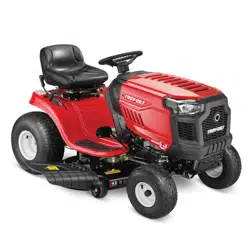Loading ...
Loading ...
Loading ...

16 Section 4 — Product care
Oil Drain Sleeve Models
WARNING
If the rider has been recently run, the engine, muffler and
surrounding metal surfaces will be hot and can cause burns to
the skin. Let the engine cool for at least five minutes Exercise
caution to avoid burns.
To complete the oil change, proceed as follows:
1. Run the engine for a few minutes to allow the
oil in the crankcase to warm. Warm oil will flow
more freely and carry away more of the engine
sediment which may have settled at the bottom
of the crankcase. Use care to avoid burns from
hot oil.
2. Open the rider’s hood and locate the oil drain
port on the left side of the engine.
3. Unscrew the oil fill cap and remove the dipstick
from the oil fill tube.
4. Snap the small end of oil drain sleeve onto the
oil sump. See Figure 4-6.
Figure 4-6
5. Remove drain plug and drain oil into a suitable
container with a capacity of no less than 64 oz.
6. Service oil filter (if equipped) as instructed in the
separate Engine Operator’s Manual.
7. Perform the previous steps in the opposite
order after oil has finished draining.
8. Refill the engine with new oil. Refer to the
Engine Operator’s Manual for information
regarding the proper quantity and viscosity of
engine oil.
Lubrication
WARNING
Before lubricating, repairing, or inspecting, always disengage
PTO, move shift lever into neutral position, set parking brake, stop
engine and remove key to prevent unintended starting
Engine
Lubricate the engine with motor oil as instructed in the
Engine Operator’s Manual.
Pivot Points & Linkage
Lubricate all the pivot points on the drive system,
parking brake and deck lift linkage at least once a
season with light oil.
Rear Wheels
The rear wheels should be removed from the axles
once a season. Lubricate the axles and the rims with an
all-purpose grease before re-installing them.
Front Axles (Hydrostatic only)
Each end of the rider’s front pivot bar may be
equipped with a grease fitting. Lubricate with a grease
gun after every 25 hours of rider operation.
Headlights
Refer to the Parts/Warranty Supplement when
replacement of head lamp bulbs is necessary.
Replace headlight bulbs as follows:
1. Fully raise the hood of the rider.
2. Unplug the wire harness leads from the
headlight socket terminals. Note which
wire connects to each terminal before
disconnecting.
3. Rotate the socket assembly approximately a
⁄-turn to align the socket tab with the reflector
housing notch; then withdraw the bulb and
socket assembly from the reflector housing. See
Figure 4-7.
Figure 4-7
4. Push the bulb inward and turn counter-
clockwise to remove from the socket.
5. Align a locking post of the bulb base with the
notch in the socket, then push the bulb inward
and turn clockwise to lock. See Figure 4-7.
6. Align the socket tab with the notch of the
reflector housing; then push the socket inward
and turn as necessary to lock the socket in the
housing.
7. Connect the wire harness leads to the
appropriate socket terminals.
Battery
WARNING
California PROPOSITION 65: Battery posts, terminals,
and related accessories contain lead and lead compounds,
chemicals known to the State of California to cause cancer and
reproductive harm. Wash hands after handling.
CAUTION
If removing the battery, disconnect the NEGATIVE (Black) wire
from it’s terminal first, followed by the POSITIVE (Red) wire.
When re-installing the battery, always connect the POSITIVE
(Red) wire its terminal first, followed by the NEGATIVE (Black)
wire.
The battery is sealed and is maintenance-free. Acid
levels cannot be checked.
• Always keep the battery cables and terminals
clean and free of corrosive build-up.
• After cleaning the battery and terminals, apply
a light coat of petroleum jelly or grease to both
terminals.
• Always keep the rubber boot positioned over the
positive terminal to prevent shorting.
Important: Be certain that the wires are
connected to the correct terminals; reversing
them could change the polarity and result in
damage to your engine’s alternating system.
Battery Failures
Some common causes for battery failure are:
• Incorrect initial activation
• Overcharging
• Freezing
• Undercharging
• Corroded connections
Note: These failures are NOT covered by your
rider’s warranty.
Charging
WARNING
Batteries emit an explosive gas while charging. Charge the
battery in a well ventilated area and keep away from an open
flame or pilot light as on a water heater, space heater, furnace,
clothes dryer or other gas appliances.
CAUTION
When charging your rider’s battery, use only a charger designed
for 12V lead-acid batteries. Read your battery charger’s Owner’s
Manual prior to charging your rider’s battery. Always follow its
instructions and heed its warnings.
If your rider has not been put into use for an extended
period of time, charge the battery as follows:
Set your battery charger to deliver a max of 10A. If
your battery charger is automatic, charge the battery
until the charger indicates that charging is complete.
If the charger is not automatic, charge for a minimum
of eight hours.
Jump Starting
WARNING
Never jump start a damaged or frozen battery. Be certain the
vehicles do not touch, and ignitions are OFF. Do not allow cable
clamps to touch.
Important: Never jump start your lawn rider’s battery
with the battery of a running vehicle.
1. Connect positive (+) cable to positive post (+) of
your lawn rider’s discharged battery.
2. Connect the other end of the cable to the
(positive +) post of the jumper battery.
Loading ...
Loading ...
Loading ...
